Blueberry Scones
- By Jennifer Segal
- Updated July 10, 2025
- 78 Comments
- Leave a Review
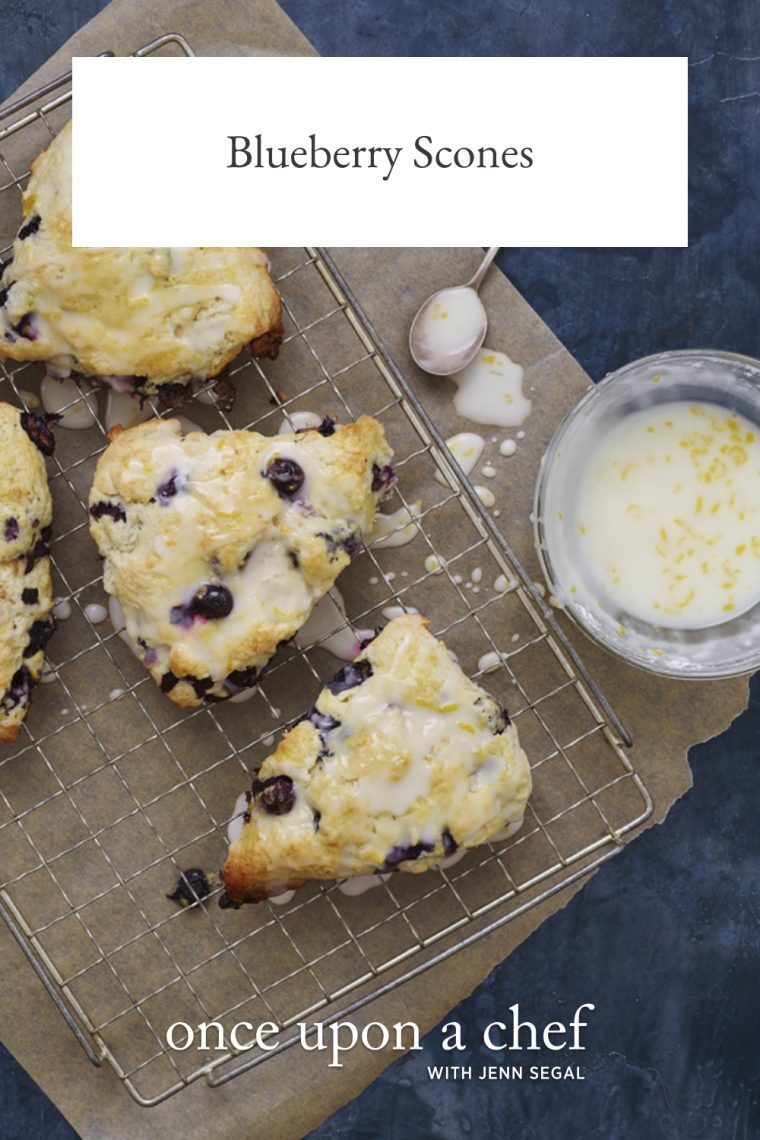
This post may contain affiliate links. Read my full disclosure policy.
Better than anything at the coffee shop, these blueberry scones are tender, loaded with berries, and finished with a lemony glaze.
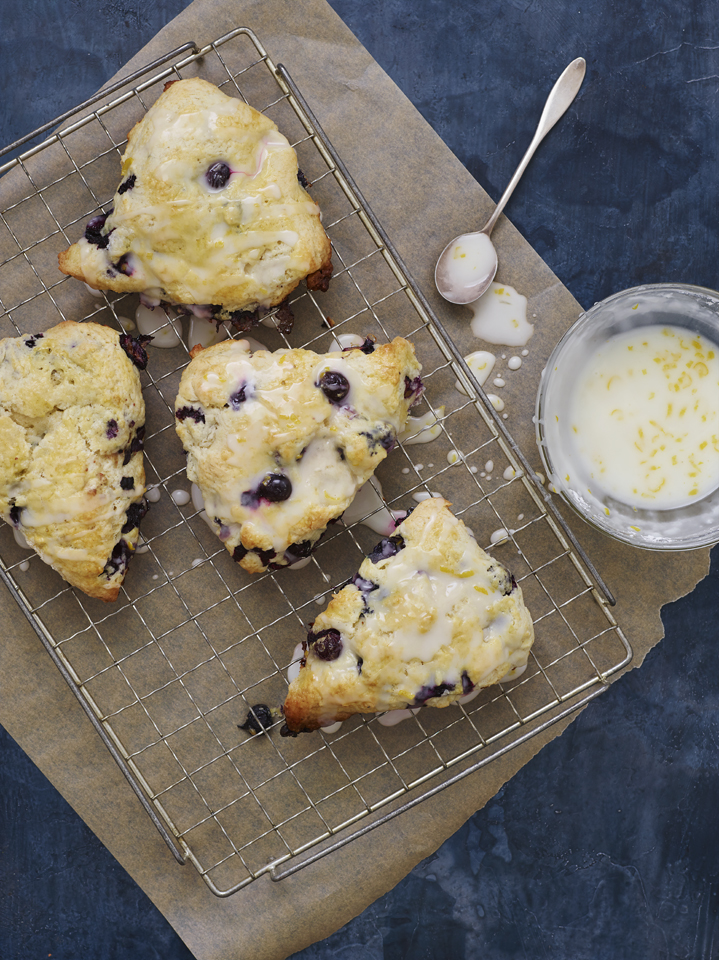
Photo by Alexandra Grablewski (Chronicle Books, 2018)
Blueberry scones (and scones in general) are often dry and crumbly, especially if they sit out for more than a few hours. Not these. Some of the blueberries burst during baking, creating little pockets of juice that keep the scones melt-in-your-mouth tender and almost cakelike for days. The lemon glaze adds a pop of bright flavor—and looks pretty too.
This blueberry scone recipe makes large scones. If you prefer smaller ones, divide the dough into two rounds instead of one, and then cut each round into 6 wedges. Also, when making scones, try to handle the dough as little as possible; a light hand makes for light and tender scones.
“I made these for my daughter and her roommates for finals week. They said they were the best scones they’ve ever had.rn”
What You’ll Need To Make Blueberry Scones
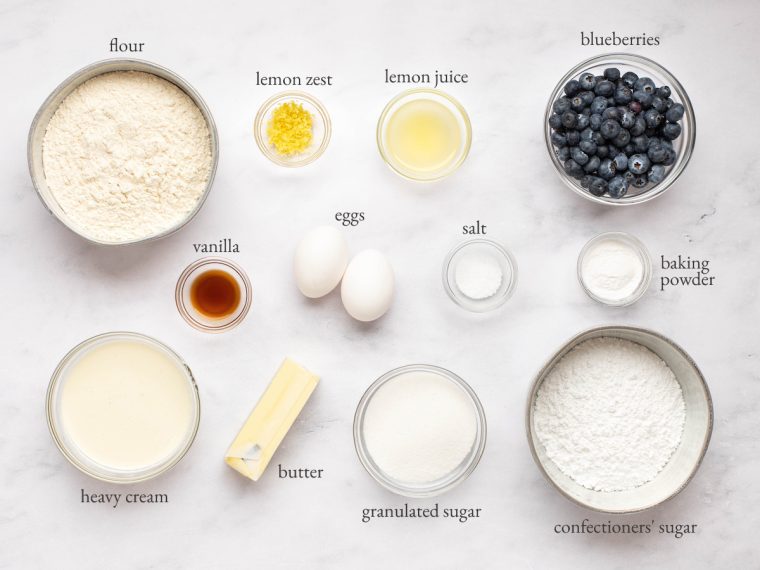
- Flour, baking powder, and sugar form the base of the scones—be sure to spoon and level the flour so the dough stays light and tender.
- Cold butter is cut into the dry ingredients for that classic flaky texture, and a bit more goes into the glaze for a smooth, rich finish.
- Eggs and heavy cream add moisture and richness; brushing a little egg on top before baking gives the scones a beautiful golden color.
- Blueberries bring bursts of fruity sweetness—fresh are best when they’re in season, but frozen work too. Just don’t thaw them first, or your dough will turn blue.
- Vanilla adds warmth and depth to the flavor
- Confectioners’ sugar, lemon zest, and lemon juice make a tangy glaze that complements the berries beautifully.
- Jump to the printable recipe for precise measurements
Step-By-Step Instructions
Step 1: Mix the dry ingredients. In a large bowl, whisk together the flour, salt, baking powder, and sugar.
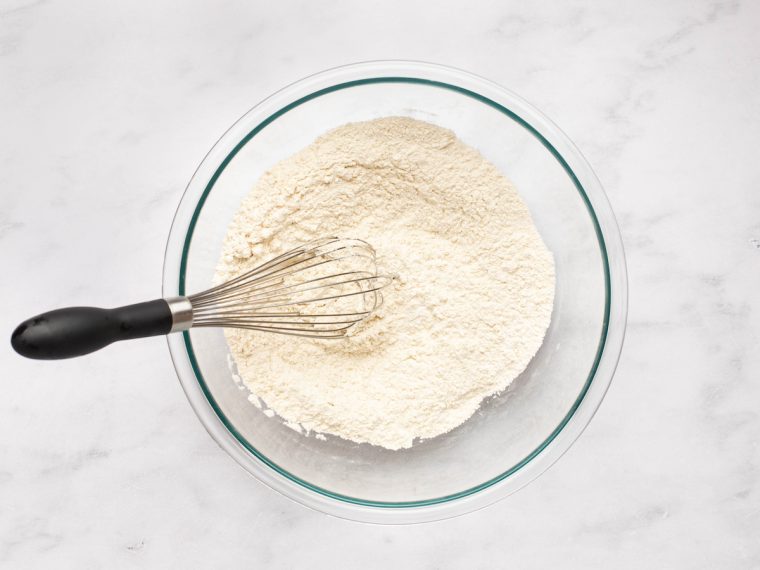
Step 2: Cut in the butter. Add the pieces of cold butter and use your fingertips to rub them into the dry ingredients until the mixture resembles coarse crumbs with pea-sized clumps of butter.
Pro tip: Keeping the butter cold is key to achieving flaky scones. The small butter pieces create pockets of steam when baked, resulting in a light, tender texture.
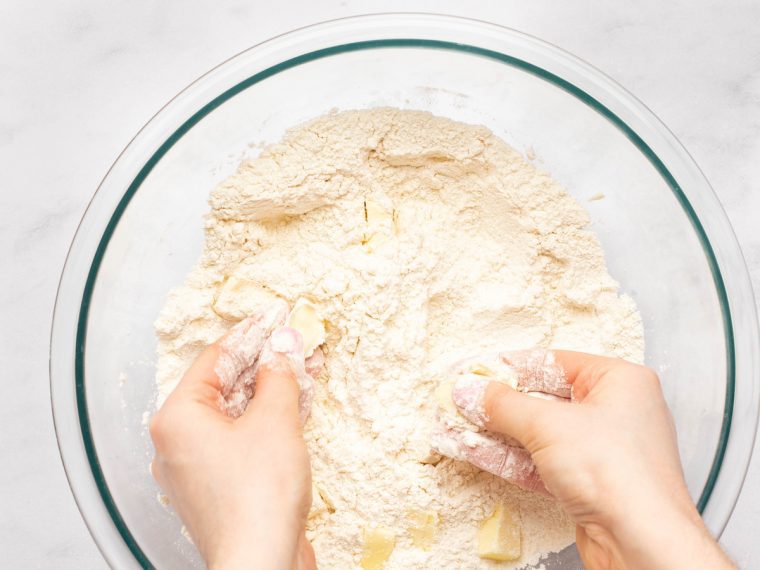
Step 3: Add the fruit. Stir in the blueberries and set aside.
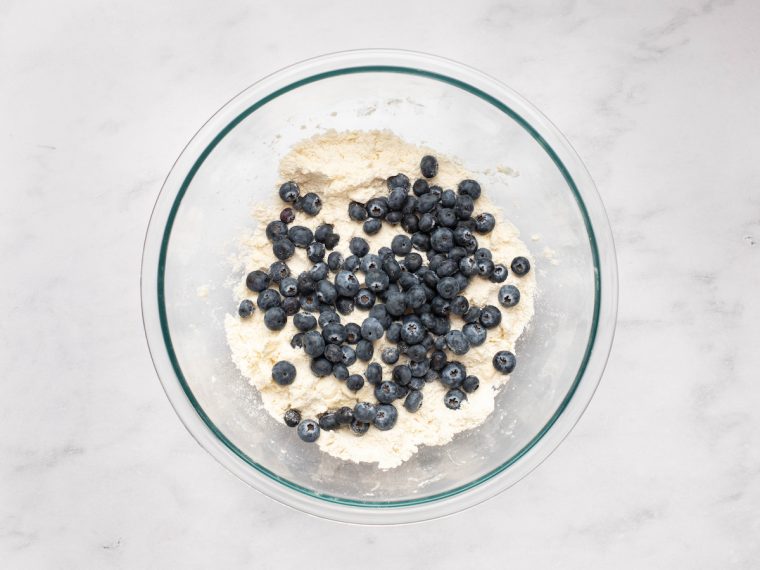
Step 4: Mix the wet ingredients. In a small bowl, whisk together the heavy cream, egg, and vanilla.
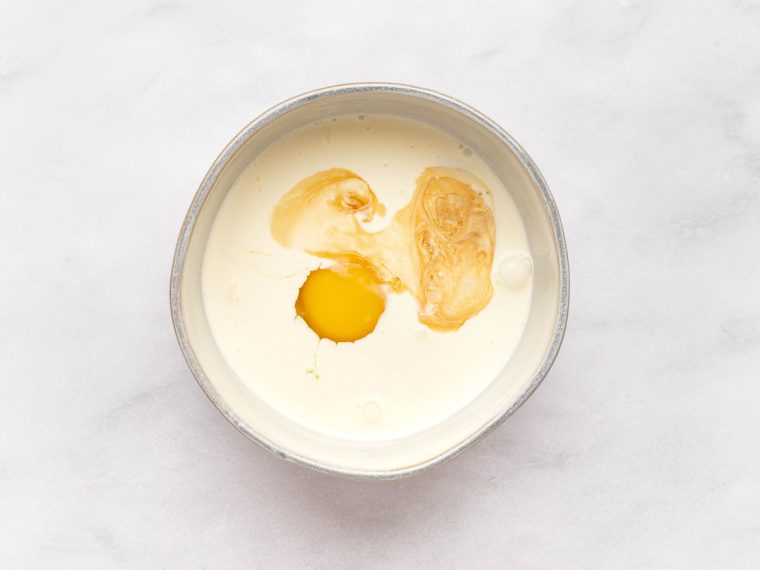
Step 5: Combine wet and dry. Make a well in the center of the dry ingredients and pour in the cream mixture.
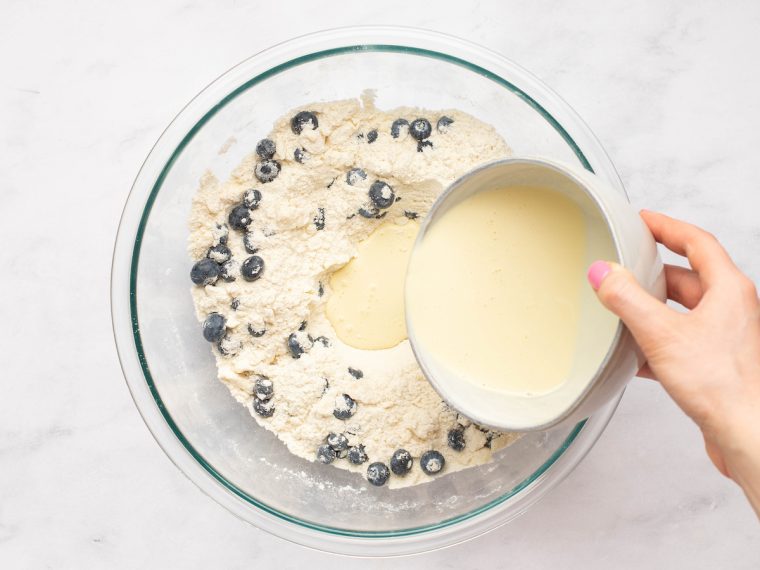
Step 6: Mix. Using a rubber spatula, stir until the dough comes together—it will be slightly crumbly. If too dry, add 1 to 2 tablespoons more cream. Try to stir gently; this will keep the blueberries from getting crushed.
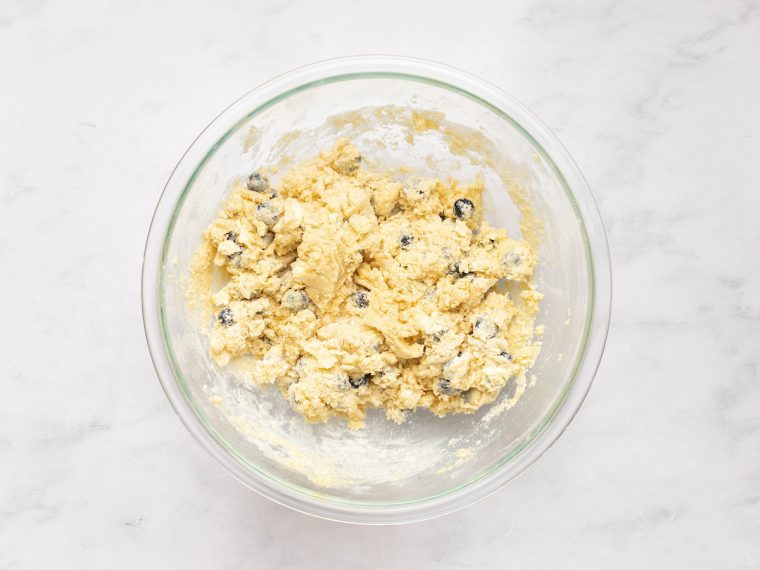
Step 7: Shape the scones. Lightly flour a work surface and turn out the dough. Lightly dust the top with flour, then knead gently into a ball. Press into a ¾-inch-high circle and cut into 8 wedges. It’s okay if you slice through some of the blueberries. (At this point, the scone dough can be refrigerated overnight and baked fresh, or frozen for up to three months and baked straight from the freezer with a few extra minutes in the oven.)
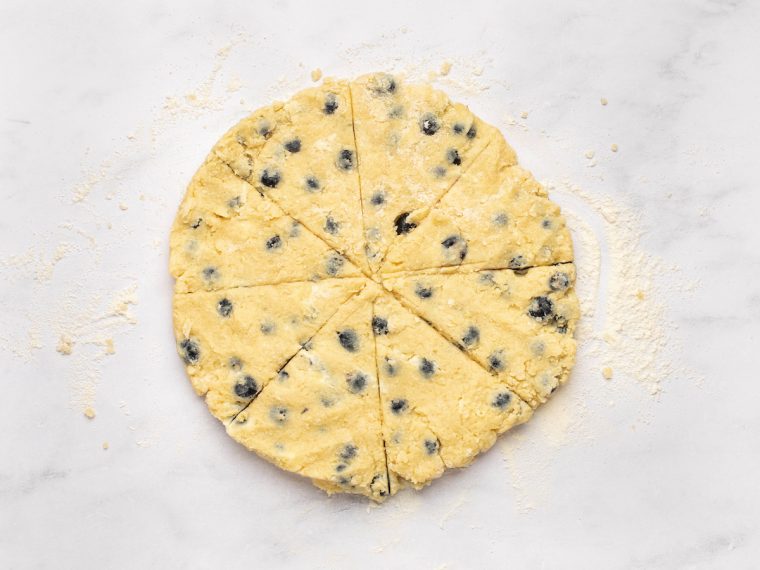
Step 8: Add egg wash. Place the scones on the prepared baking sheet, spacing them at least 1 inch apart. Beat the remaining egg in a small bowl and brush the tops (you won’t use all of it).
Pro tip: An egg wash is simply a beaten egg—sometimes mixed with a little water, milk, or cream—that’s brushed onto pastry or dough before baking. It helps baked goods develop a golden, glossy finish.
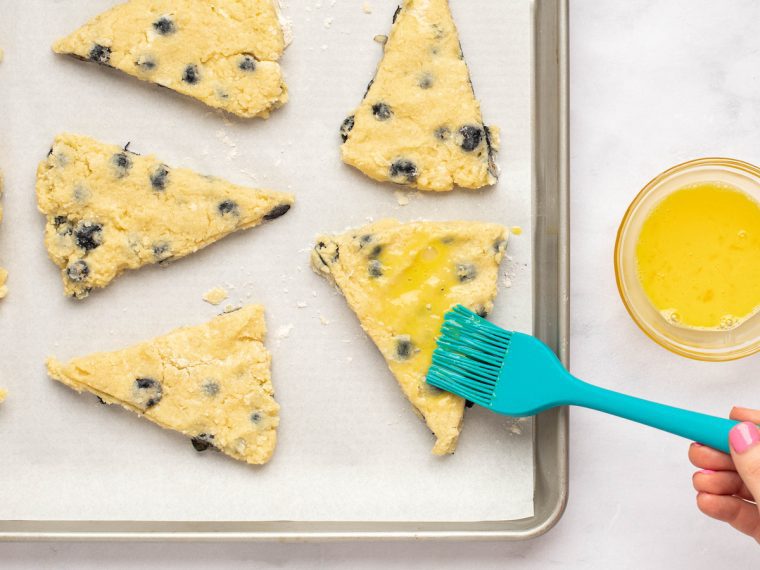
Step 9: Bake. Slide the baking sheet into a preheated 400°F oven for 17 to 20 minutes, until golden and firm to the touch. Transfer to a wire rack to cool.
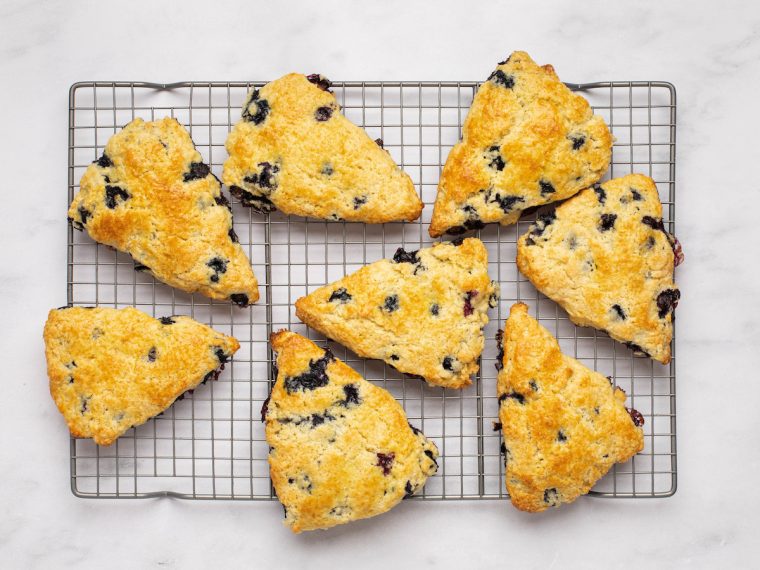
Step 10: Make the glaze. Slide the used parchment paper under the rack to catch drips. In a small bowl, whisk together the melted butter, confectioners’ sugar, lemon juice, and zest.
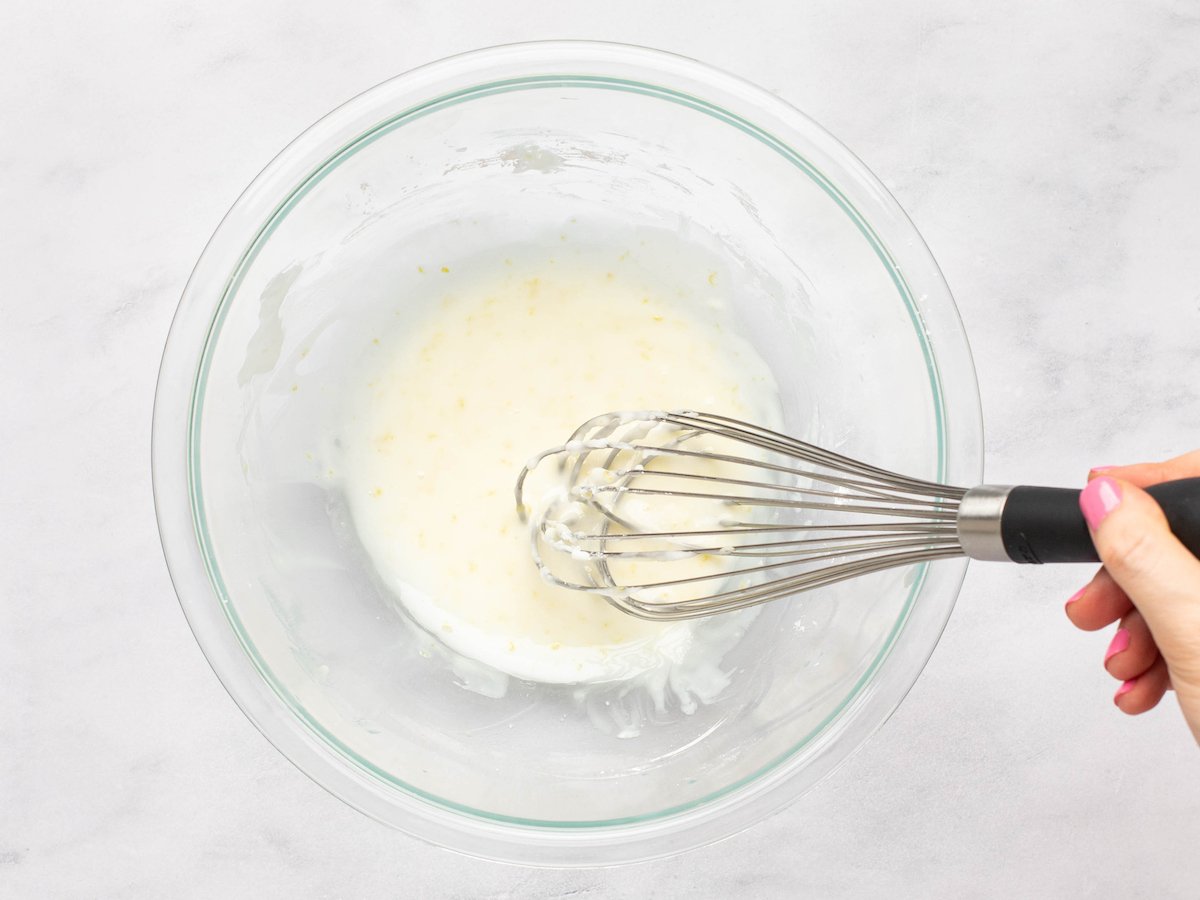
Step 11: Glaze. Before glazing, make sure the scones are completely cool to prevent the glaze from dripping off. Using a small spoon, drizzle the tops with the glaze. Let set, then serve and enjoy!
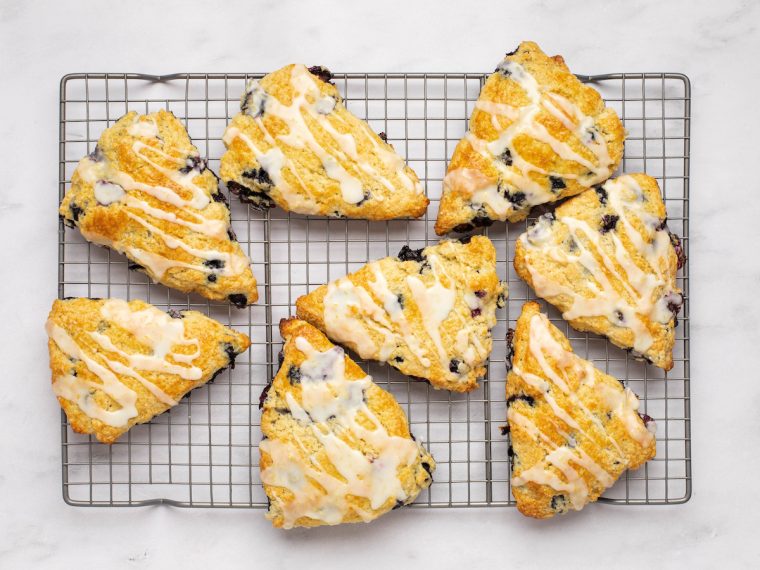
You May Also Like
Blueberry Scones with Tart Lemon Glaze
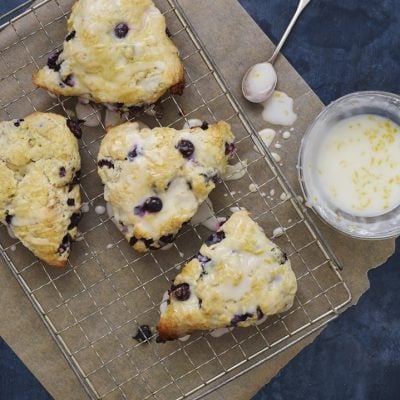
Ingredients
For the Scones
- 2 cups all-purpose flour, spooned into measuring cup and leveled-off, plus more for dusting
- ¾ teaspoon salt
- 1 tablespoon baking powder
- ½ cup granulated sugar
- 6 tablespoons cold unsalted butter, cut into ½-inch (13-mm) pieces
- 1 heaping cup blueberries
- ⅔ cup heavy cream, plus 1 to 2 tablespoons more, if necessary
- 1 large egg
- 1 teaspoon vanilla extract
For Glazing Before Cooking
- 1 large egg
For Tart Lemon Glaze
- 1 teaspoon butter, melted
- 1 cup confectioners' sugar
- 1 teaspoon lemon zest, from 1 lemon
- 2 tablespoons freshly squeezed lemon juice, from 1 lemon
Instructions
- Preheat the oven to 400°F (205°C) and set an oven rack in the middle position. Line a 13 x 18-inch (33 x 46-cm) baking sheet with parchment paper.
- In a large bowl, whisk together the flour, salt, baking powder and sugar. Add the pieces of cold butter. Use your fingertips to rub the butter into the dry ingredients until the mixture resembles coarse crumbs with pea-sized clumps of butter within. Stir in the blueberries.
- In a small bowl, whisk together the heavy cream, egg and vanilla. Make a well in the center of the dry ingredients, then add the cream mixture. Using a rubber spatula, mix until the dough comes together. It will be a bit crumbly—that’s okay. If it’s too dry to come together, add 1 to 2 tablespoons more cream and mix again.
- Dust a work surface lightly with flour; put the dough on top. Dust the dough lightly with flour, then knead gently into a ball. Press the dough into a circle about ¾-inch (2-cm) high, then cut into 8 wedges. It’s okay if you slice through some of the blueberries.
- Place the unbaked scones onto the prepared baking sheet at least 1-inch apart. Beat the remaining egg in a small bowl and use it to brush the tops of the scones (you won’t use all of it). Bake for 17 to 20 minutes, until golden and firm to the touch. Transfer the scones to a wire rack to cool. Slide the used parchment paper underneath the rack. (The parchment will catch any drips from the glaze).
- While the scones cool, make the glaze: In a small bowl, whisk together the melted butter, confectioners’ sugar, and lemon juice and zest. When the scones are completely cool, drizzle the glaze over top. (Hint: if the glaze seems too stiff to drizzle, warm it in the microwave for 5 to 10 seconds.) Let the glaze set, then serve.
Notes
- When making scones, try to handle the dough as little as possible—a light hand makes for light and tender scones.
- Make-Ahead/Freezer-Friendly Instructions: The scone dough can be made, shaped, and refrigerated overnight, and then baked directly from the fridge as directed. To freeze the dough, place the raw scones on a baking sheet until they are solid, and then transfer them to an airtight container and freeze for up to 3 months. To bake, remove the scones from the freezer while you preheat the oven. Cook as directed, but allow an extra few minutes of baking time.
Nutrition Information
This website is written and produced for informational purposes only. I am not a certified nutritionist and the nutritional data on this site has not been evaluated or approved by a nutritionist or the Food and Drug Administration. Nutritional information is offered as a courtesy and should not be construed as a guarantee. The data is calculated through an online nutritional calculator, Edamam.com. Although I do my best to provide accurate nutritional information, these figures should be considered estimates only. Varying factors such as product types or brands purchased, natural fluctuations in fresh produce, and the way ingredients are processed change the effective nutritional information in any given recipe. Furthermore, different online calculators provide different results depending on their own nutrition fact sources and algorithms. To obtain the most accurate nutritional information in a given recipe, you should calculate the nutritional information with the actual ingredients used in your recipe, using your preferred nutrition calculator.
See more recipes:
Comments
Add a Comment Cancel reply
This site uses Akismet to reduce spam. Learn how your comment data is processed.

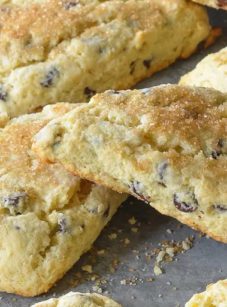

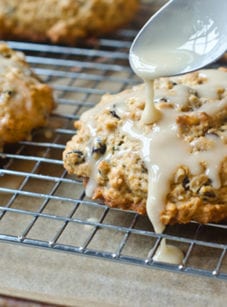
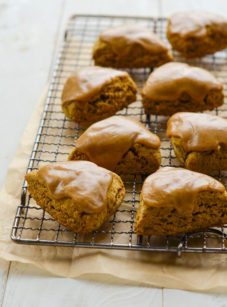
Do you think I can freeze these before baking? Looking to make ahead, freeze unbaked, and then pull them out of the freezer the night before while I’m hosting family for the weekend. Any adjustments needed?
Hi Kim, that would be fine. See guidance from this recipe for more details. 🙂
Best scone I’ve ever eaten!
These are exactly the blueberry scones I have been looking for. Thank you. So yummy.
I do have a question:
Can I use this recipe as a basic scone as well? Sometimes I want a cheddar and herb scone, so I am wondering, can I use this recipe?, omitting the blueberries and glaze adding 1 cup of shredded cheddar and a tablespoon of herbs
I just love all the recipes I have made of yours.
Thank you
Hi Gina, so glad you enjoyed these! Instead of using this as a base for savory scones, I have a recipe for one on page 234 of my first cookbook. If you don’t own the cookbook, email me at jennifer@onceuponachef.com and I’d be happy to send you the recipe. 🙂
These are amazing! When I was making them, I questioned whether or not I should make two smaller rounds of dough and make smaller scones, but so glad I stuck with the recipe as I wanted to eat every last bite of mine! These have a refreshing degree of moisture due to the blueberries, but still are very scone-like. I love the idea of lemon and berries together and the blueberry glaze on top just elevated these to the next level. These will remain on my baking list for whenever I have nice fresh, blueberries – thanks Jenn for all of these beautiful recipes!
I’ve made scones before, but I think something went very wrong with this recipe. I’m a little confused. Your recipe said to add one egg to the cream mixture. But then when making the scones, it said, ‘use remaining egg’ to brush on top.What ‘remaining’ egg would that be? My batter was so wet. I added flour and still it was too gooey. So my question is: how many eggs are supposed to be used in the total recipe? Thanks
Hi Joni, I’m sorry that you had a problem with the scones! The recipe calls for a total of two eggs. You use one egg in the dough and the other for an egg wash brushed on top of the scones prior to baking. The dough should not have been very wet – is there a chance you made a measuring error? Regardless, I’m sorry you struggled with these!
Did you use the metric or US measurements? I’ve made them twice and when I used the metric, I also found the batter WAY to wet. I compared the measurements to the weight and they don’t line up so maybe just stick with the US measurements.
Hi Jenn, I have an event coming up where I’m supposed to bring baked goods. I thought your scones would fit the bill perfectly. I’d like to make them on the smaller side, though—like mini scones, so to speak. Any idea how to adapt this recipe? Also, any thoughts on how many minis this recipe would make? As always, thanks for all the wonderful recipes!
Hi Alex, I’d make the dough for the scones and instead of forming the dough into one large disc, I’d split it in half and form it into two. Then cut each disc into 8 triangles (like you would for the larger ones). I’d bake them at the same temp and start checking them for doneness at about 10 minutes. I’d love to hear how they come out as minis!
I made them mini! They still took about 16 minutes to bake, although I began checking at 10 minutes. They are delicious! I was a bit worried because my blueberries started to burst inside the dough as I was forming it, but it doesn’t have an impact on the taste or even the overall look. I made two batches, and my second batch was by far better as I used more flour when I went to form the dough ball and then discs. I will definitely be making these again! I have a summer full of visiting guests and now I have a treat ready for the first morning. Thanks!!!
So glad that they turned out nicely and good to know about the baking time — thanks for reporting back! 🙂
Hi Jen,
I’ve recently started substituting evaporated milk for heavy cream in some recipes, with great success. Would it work here? And can you give me a general rule of thumb for when it wouldn’t work? Thanks so much.
Hi Jan, I’m not 100 percent sure, but I think it would probably work for scones, but I wouldn’t use it in cooking. Please report back if you try it. I’d love to hear how they turn out!
Easy and awesome, like all your recipes, Jenn! Thank you!
How would I adapt this recipe for cranberry orange scones? Would I simply replace the bb for cranberries and just add jest of one orange?
Thanks again for your delicious recipes!
So glad you enjoyed them, Sue! I actually have a recipe for cranberry orange scones on page 202 of my second cookbook. If you don’t own the cookbook, email me at jennifer@onceuponachef and I’ll email you the recipe.
Hi Jenn, Like everyone else here, I love your recipes. Your site has become my go-to after the demise of Fine Cooking. I KNOW what I make will be good!! I’m wondering if you could make the glaze ahead and freeze it (separately of course) along with the scones. It would be nice to have everything available in the freezer when I need it.
So glad you’re enjoying the recipes, Leah! I do think that would work well.
It was perfect! Thanks so much. These will become a regular in my diet.